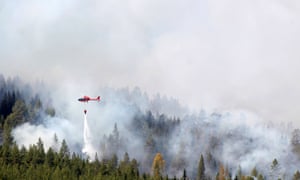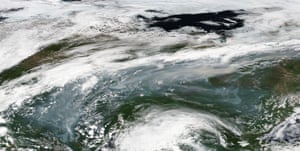Sweden worst hit as hot, dry summer sparks unusual number of fires, with at least 11 in the far north
At least 11 wildfires are raging inside the Arctic Circle as the hot, dry summer turns an abnormally wide area of Europe into a tinderbox.
The worst affected country, Sweden, has called for emergency assistance from its partners in the European Union to help fight the blazes, which have broken out across a wide range of its territory and prompted the evacuationsof four communities.
Tens of thousands of people have been warned to remain inside and close windows and vents to avoid smoke inhalation. Rail services have been disrupted.
The Copernicus Earth observation programme, which gives daily updates of fires in Europe, shows more than 60 fires burning across Sweden, with sites also ablaze in Norway, Finland and Russia, including in the Arctic Circle.
Norway has sent six fire-fighting helicopters in response to its neighbour’s request for assistance. Italy is sendingtwo Canadair CL-415s – which can dump 6,000 litres of water on each run – to Örebro in central southern Sweden.
In western Sweden, fire-fighting operations were temporarily halted near an artillery training range near Älvdalen forest due to concerns that unexploded ordnance might be detonated by the extreme heat.
Residents in Uppsala said they could see the plumes of smoke and have been banned from barbecuing in national parks, after 18 consecutive days without rain.
“This is definitely the worst year in recent times for forest fires. Whilst we get them every year, 2018 is shaping up to be excessive,” said Mike Peacock, a university researcher and local resident.
There have been huge fires in the past in Sweden, but not over such a wide area. This appears to be a trend as more and bigger blazes are reported in other far northern regions like Greenland, Alaska, Siberia and Canada.
The sparks come from a variety of sources: BBQs, cigarettes and increasingly lightning, which is becoming more frequent as the planet warms.
Swedish authorities say the risk of more fires in the days ahead is “extremely high” due to temperatures forecast in excess of 30C. Much of the northern hemisphere has sweltered in unusually hot weather in recent weeks, breaking records from Algeria to California and causing fires from Siberia to Yorkshire. Ukraine has been hit especially hard by wildfires
Climate scientists said the Arctic and other areas that were once relatively fire-free are likely to become more vulnerable.
“What we’re seeing with this global heatwave is that these areas of fire susceptibility are now broadening, with the moors in north-west Englandand now these Swedish fires a consequence of that,” said Vincent Gauci, professor of global change ecology at the Open University.
“Both these areas are typically mild and wet which allows forests and peatlands to develop quite large carbon stores,” he added. “When such carbon-dense ecosystems experience aridity and heat and there is a source of ignition – lightning or people – fires will happen.”
Since you’re here…
… we have a small favour to ask. More people are reading the Guardian than ever but advertising revenues across the media are falling fast. And unlike many news organisations, we haven’t put up a paywall – we want to keep our journalism as open as we can. So you can see why we need to ask for your help. The Guardian’s independent, investigative journalism takes a lot of time, money and hard work to produce. But we do it because we believe our perspective matters – because it might well be your perspective, too.
The Guardian is editorially independent, meaning we set our own agenda. Our journalism is free from commercial bias and not influenced by billionaire owners, politicians or shareholders. No one edits our Editor. No one steers our opinion. This is important because it enables us to give a voice to the voiceless, challenge the powerful and hold them to account. It’s what makes us different to so many others in the media, at a time when factual, honest reporting is critical.
If everyone who reads our reporting, who likes it, helps to support it, our future would be much more secure. For as little as $1, you can support the Guardian – and it only takes a minute. Thank you.














Đăng nhận xét